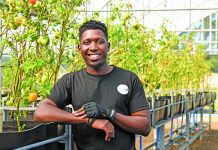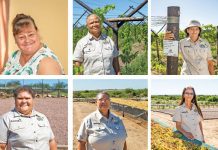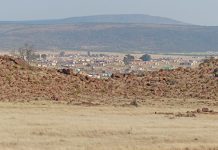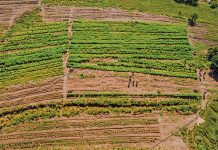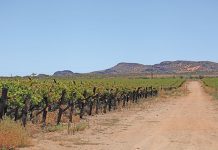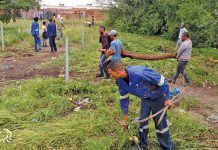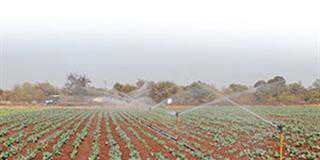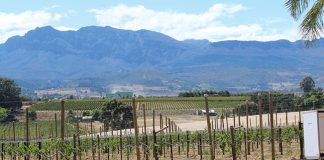Paul Ngcobo estimates that about 2 500 people make up the KwaDindi community where he lives. Even though KwaDindi is near Pietermaritzburg, jobs are scarce. However, government grants, household vegetable gardens and small-scale agriculture keep residents from starving.
This made KwaDindi a natural choice when the KZN Department of Agriculture, Environmental Affairs and Rural Development (DAEARD) was looking for a place to start a community-based commercial oyster mushroom cultivation project in early 2005. It recognised that Paul and others in the community had become good at producing the most food they can from the little vacant land they have.
Participating KwaDindi residents have made such a success of this trial that the KZN DAEARD is building a commercial oyster-mushroom production facility in the area.
“It’s so easy to grow these mushrooms,” says Paul. “The department gives us bags of growing medium already inoculated with oyster-mushroom spawn. Then it’s up to us to water and care for the growing mushrooms. If it’s warm we can harvest our trenches twice a week, although this drops to once a week when it’s cold. A bag of inoculated growing medium can be harvested for as long as three months.”
Becoming an oyster-mushroom grower
Paul is one of the key drivers behind the success of the project and was trained at Juncao Institute of China’s Fujian Agriculture and Forestry University.
About 60 community members are growing oyster mushrooms for home consumption and for sale. When the nearby production support facility is operational, hopefully by October, this number is expected to reach 350.
Each grower will first be trained in oyster mushroom production at the KZN DAEARD’s new isiKhowe Mushroom Research and Training Centre at Cedara, and will receive two or more 1m x 3m mushroom-growing trenches in KwaDindi’s communal tunnels.
“People won’t stop growing other food crops in their gardens and small plots,” says Paul. “The mushroom farming simply adds food to their tables.”
Oyster-mushroom farming for poverty alleviation appealed to the KZN DAEARD because the production technology from China grows mushrooms in waste organic material that’s cheaply and readily available.
Currently, the department uses shredded bagasse – dried-out sugarcane stalks – as the growing medium. Other materials that can be used include Napier fodder, lantana, wattle residue and chicken litter.
The KZN DAEARD is also looking at using invasive-alien plant species, thatching grass and phragmites reeds. China’s Juncao Institute says that a broad range of suitable surplus or inedible growing media means growers won’t have to harvest trees and scarce resources.
Furthermore, at the end of a three-month production period, the depleted medium can be used as compost in community vegetable gardens.
Growers supporting themselves
Paul says the KZN DAEARD gives KwaDindi’s oyster-mushroom farmers almost everything they need to grow their crop, but once the commercial production facility is operational, this support will gradually decrease until farmers pay for all aspects of the value chain.
The KZN DAEARD will continue to offer technical support and training to farmers whenever necessary, but the ultimate goal is for the community to have a self-sustainable commercial business.
“Around 35 people have been trained at Cedara to carry out all the preparations for the bags of inoculated growing medium at the production support facility,” says Paul. “KwaDindi’s mushroom growers will buy the bags from the facility, grow and harvest the mushrooms, then sell them to the facility. The facility will also find markets to sell the mushrooms, which get a higher price than button mushrooms.”
Paul admits that during the trial the participating growers sold most of their oyster-mushroom crop in KwaDindi and its immediate surrounds at ridiculously low prices.
“We didn’t realise how special and uncommon oyster mushrooms are in South Africa,” he chuckles. “Even so, until now, KwaDindi’s oyster mushroom growers have made at least R2 500 from a trench over a three-month period. This amount will increase once we start selling on a large scale at the right prices.”
The growers will eventually pay their own inputs, and are already planning for this. They compile detailed records of exactly how much it costs to properly manage their crops to factor in the selling price to the support facility.
“Our growers have also started putting money together in a joint bank account to prepare for paying their costs,” says Paul. “We’re even going to employ security guards for the support facility because there will always be one or two people in our community who are too lazy to grow oyster mushrooms and would rather steal from the facility.”
The future of oyster mushrooms
Government officials are already analysing the potential for South Africa to start exporting oyster mushrooms.
And with the KZN DAEARD keenly interested in establishing more satellite oyster-mushroom production facilities around the province, it’s likely the project will develop export capacity.
“When we start processing our own growing medium on site, it’ll be a lot faster than it can be done at Cedara, and we could replace the bags more frequently than every three months,” explains Paul. “This means our yields should stay constantly high, only changing as the temperature changes.
“Many unemployed people in KwaDindi who weren’t in the trial now want to join us. If we can have at least one person from each family growing oyster mushrooms here, the income from the mushrooms will help uplift their families, who will realise that it’s important to support the growers and to protect the facility.”
Contact Paul Ngcobo on 082 298 9637.

